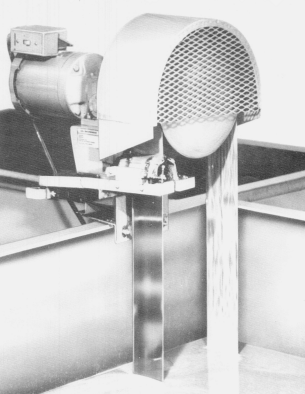Coolant Skimmers Cure a Header Headache
 This Abanaki coolant skimmer is one of five units that improves wastewater recycling for a major Cleveland bolt maker. The end result created a clean and clear environment without the dense smoke and haze that surrounded the bolt making machines in the past. The endless metal belt can be seen removing oil clinging to it, pulling wastes from the tank of coolant over the drive pulley and past doctor blades that scrape the residue off both sides of the belt. Previously the lubricating oil, left in the coolant, emitted dense smoke and haze as it contacted the hot bolts in the trimming process. Skimming of the oil from the coolant permits machine coolant recycling for up to 90 days, and has resulted in virtual elimination of the smoke and haze problem at Lake Erie Screw Corporation, Cleveland. Abanaki Corporation manufactures the oil skimmers.
This Abanaki coolant skimmer is one of five units that improves wastewater recycling for a major Cleveland bolt maker. The end result created a clean and clear environment without the dense smoke and haze that surrounded the bolt making machines in the past. The endless metal belt can be seen removing oil clinging to it, pulling wastes from the tank of coolant over the drive pulley and past doctor blades that scrape the residue off both sides of the belt. Previously the lubricating oil, left in the coolant, emitted dense smoke and haze as it contacted the hot bolts in the trimming process. Skimming of the oil from the coolant permits machine coolant recycling for up to 90 days, and has resulted in virtual elimination of the smoke and haze problem at Lake Erie Screw Corporation, Cleveland. Abanaki Corporation manufactures the oil skimmers.
Coolant skimmers are being used in a major Cleveland bolt making plant to clean liquid coolant and clear the air, virtually eliminating the oil smoke and haze that are inherent in hot heading applications. The coolant skimmers are equally efficient in less demanding press operations.
Lake Erie Screw Corporation installed the five coolant skimmers – they are Abanaki models – to serve from one to seven headers each. Coolant from machines in each group is piped to a separate reservoir where the oil skimmer removes oily waste at a rate of 32 gallons per hour. The cleaned coolant is then recycled back to the machines.
Chief Engineer Chester Czerski defined the problem. Prior to the installation of the skimmers, each machine held its own light-weight coolant which combined with the machine lubricating oil seeping from oiled parts into the common reservoir. As the oily coolant was sprayed on the hot bolts in the trimming operation, the oil smoked, emitting a heavy haze which hung in the air around each piece of equipment. At times, on the larger machines, the visibility in the area was less than 10 feet.
Today the plant is virtually clear and clean, with a lower cost coolant undergoing continuous recycling for periods up to 90 days. Present coolants are 95 percent water and five percent soluble oil. Application of the coolant to the heated bolt in the trimming process produces virtually no emission. Lubricating oil which seeps from the machine into the reservoir combines with the coolant which is piped to the holding tanks where it is removed by the oil skimmers. The coolant is recycled after removal of the lubricating oil.
Operation of the Abanaki coolant Skimmer is based on the principle that oil is attracted to and will adhere to metal while other liquids will not. The skimmer’s endless metal belt draws the oily wastes up out of the liquid being cleaned, over the head pulley and past doctor blades which remove the oily residue from both sides of the belt. The oil drains into a trough from which it flows to a collecting tank or drum.
A unique part of the Abanaki oil skimmer operation is the ability of the head pulley to drive the belt without interfering with the oily residue on both sides of the belt. A free-riding tail pulley stabilizes belt operation but permits it to bend around floating obstructions that might damage permanently secured equipment.
A typical Abanaki unit with eight-inch belt has the capacity to improve wastewater recycling by 32 gallons of waste oil per hour. With multiple belts capacity can be increased to 160 gallons per hour. Because the endless belt is available in almost any length and the tail pulley is free riding, the unit can be furnished with various belt lengths depending on the height of the liquid to be cleaned. and the height to which the removed residue is to be raised. Changes in liquid height do not affect efficiency of the skimmer.
The Abanaki coolant skimmer is available with a nickel belt and with stainless steel construction. A heated model also is available for use in external applications where low temperatures tend to solidify oily wastes. The heated unit is particularly applicable to removal of any oil, grease or fat which tends to solidify at ambient temperatures. Other units are also available in special materials to withstand high alkaline or high acid solutions.

